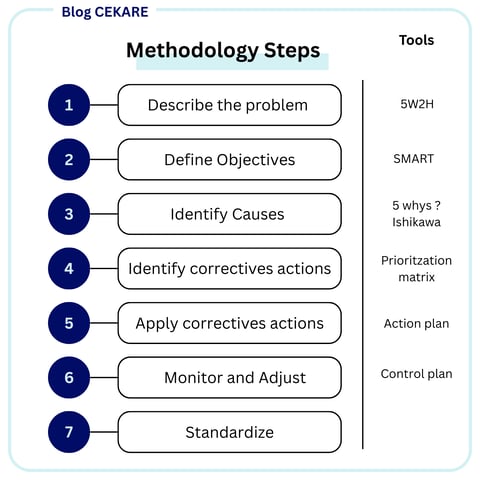Problem solving – Methods and Tools
Baptiste CARRE
3/27/20252 min read
Every business faces challenges—whether it’s a production delay, a customer complaint, or inefficiencies in a process. But the real difference between successful and struggling organizations lies in how they tackle these problems.
In this article, we will embark on a comprehensive exploration of problem-solving, addressing the following essential topics:
Defining the core principles of "problem-solving."
Outlining the systematic steps involved in the problem-solving process.
Providing a comprehensive overview of well-known problem-solving methods and guiding you in selecting the best approach for various situations.
Introducing effective tools to enhance the efficiency and success of your problem-solving efforts.
What is problem solving ?
At its core, a problem is a situation that presents a challenge or an obstacle, preventing you from achieving a desired outcome. In the context of a business or an organization, problems can manifest in various ways, such as inefficiencies in processes, quality issues, or failures in meeting customer expectations. Recognizing a problem is the first step toward resolving it, and it often involves identifying a gap between the current state and the desired state.
Problem-solving isn’t just about fixing issues when they arise; it’s about creating a culture where teams continuously improve and prevent problems from recurring. This mindset is the foundation of Lean Management and Continuous Improvement, helping companies stay competitive, efficient, and innovative.
Facing problems and resolving them will :
Enhance Operational Efficiency: By identifying and addressing inefficiencies, companies can streamline their processes, reduce waste, and improve overall productivity.
Drive Innovation: Problem-solving encourages creative thinking and the exploration of new ideas, leading to innovative solutions that can set a company apart from its competitors.
Improve Customer Satisfaction: Addressing problems promptly and effectively enhances the quality of products and services, leading to higher customer satisfaction and loyalty.
Empower Employees: When teams are equipped with problem-solving skills, they feel more empowered and engaged. This leads to increased job satisfaction and a more proactive approach to challenges.
Promote a Culture of Continuous Improvement: Effective problem-solving fosters a mindset of continuous improvement, where employees are constantly seeking ways to enhance processes and outcomes.
Mitigate Risks: By proactively identifying and addressing potential issues, companies can mitigate risks and prevent small problems from escalating into major crises.


Problem solving :
Going steps by steps.
To resolve a problem you are facing, whatever the methodology you will use, you will follow a similar path.
Describe the Problem : Clearly articulate the problem. Go on the field, exchange with people involved in processes and collect facts. Identify what is the gap between the current situation and the expected situation. Asking yourself what's going wrong, and why is it important to fix?
Define Objectives : Set clear and measurable goals based on precise criteria - cost, time, quality, or criteria suitable for your business performance. What do you want to achieve by resolving this problem successfully?
Identify Causes : This step aimed to understand where the problem is coming from! Use tools like the 5 Whys and Ishikawa diagrams to uncover root causes. Keep asking "why" until you hit the core issue.
Identify Corrective Actions : Now that the causes are identified, brainstorm potential corrective actions with your teams. Select the most appropriate ones based on their feasibility and impact.
Apply Corrective Actions : Implement and execute corrective actions, start with the “quick-win” ones with immediate effect. Ensure everyone knows their role and communicates effectively to apply them.
Monitor and Adjust : Track the progress following the applications of the corrective actions using metrics and data. Make adjustments if needed based on feedback and results. Are the corrective actions working?
Standardize : Document your success and make it the new standard. Share your findings with other teams to replicate the improvement.
CEKARE
Boost your operational and industrial performance.
Mail : contact@cekare.eu
Phone : +370 663 58 502
© 2025. All rights reserved.
